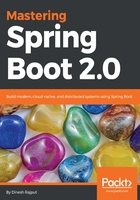
上QQ阅读APP看书,第一时间看更新
Learning how auto-configuration works
Let's see what the @Conditional annotation does:
- It allows conditional bean creation. It only creates a bean if other beans exist (or don't exist) as follows:
@Bean
@ConditionalOnBean(name={"dataSource"})
public JdbcTemplate jdbcTemplate(DataSource dataSource) {
return new JdbcTemplate(dataSource);
}
- Or @Conditional annotations allow us to create the bean by checking the type of other classes:
@Bean
@ConditionalOnBean(type={DataSource.class})
public JdbcTemplate jdbcTemplate(DataSource dataSource) {
return new JdbcTemplate(dataSource);
}
- There are many other options available under @Conditional annotation, as follows:
- @ConditionalOnClass
- @ConditionalOnProperty
- @ConditionalOnMissingBean
- @ConditionalOnMissingClass
Let's see what the auto-configuration class looks like in Spring Boot.
It is a pre-written Spring configuration in the org.springframework.boot.autoconfigure package in the spring-boot-autoconfigure JAR file:
@Configuration
public class DataSourceAutoConfiguration implements EnvironmentAware {
...
@Conditional(...)
@ConditionalOnMissingBean(DataSource.class)
@Import(...)
protected static class EmbeddedConfiguration { ... }
...
}
Spring Boot defines many of these configuration classes. They are activated in response to dependencies on the classpath of your Spring application.
Let's see how to customize Spring Boot auto-configuration in your Spring application in the next section.